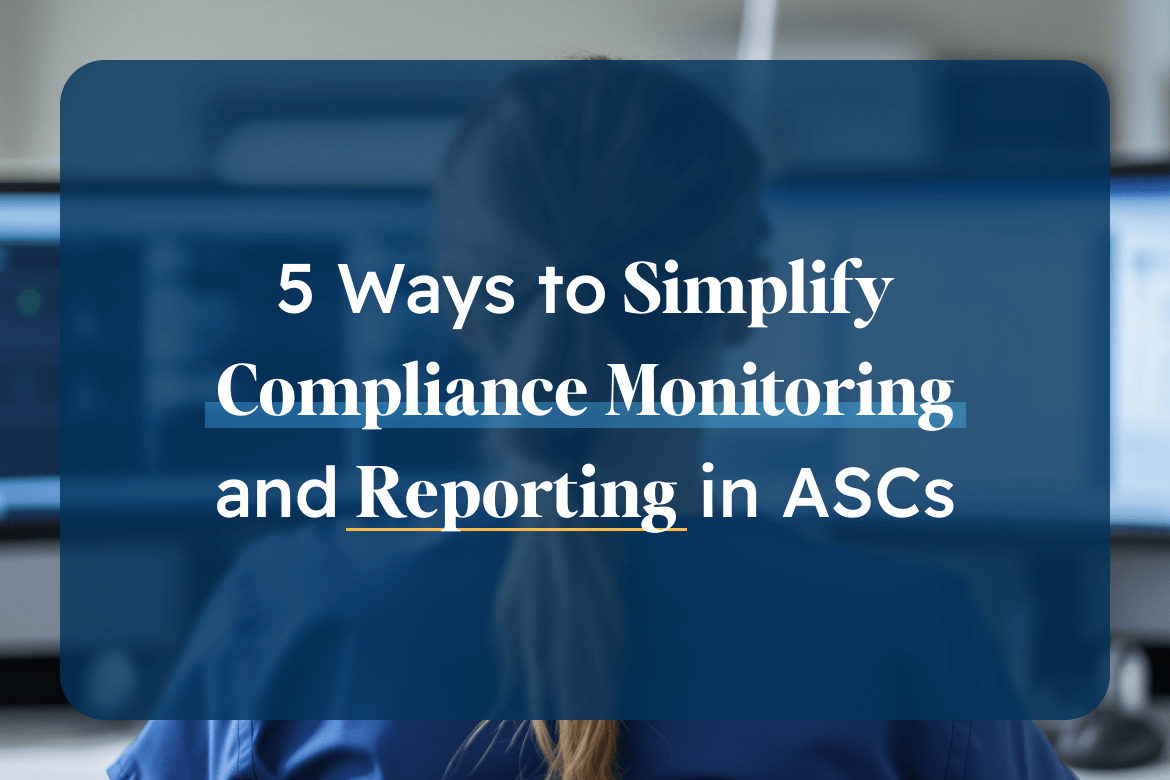The not-so-convenient truth about simplification is that, well, it’s not always so simple. As is the case with simplifying compliance monitoring and reporting at Ambulatory Surgery Centers (ASCs). So, the question is – Why Simplify?
There are many benefits to simplifying compliance at your ASC. First, the time-saving benefits. Simplifying compliance monitoring reduces the time and resources spent on manual tracking and reporting, allowing staff to focus on patient care and other critical tasks. In addition, simplified systems help ensure that all necessary regulations are consistently met, minimizing the risk of fines, audits, or legal penalties. Finally, a more streamlined approach reduces human error and ensures that compliance data is accurate and up-to-date. This consistency leads to better decision-making and a more reliable reporting process, which is crucial for both internal and external audits.
Although implementing these processes and solutions may require an initial time investment, the long-term benefits for your ASC will be substantial. In this article, we will explore five strategies for simplifying compliance challenges. These approaches can be applied collectively or individually, depending on your needs. Regardless of how you choose to integrate these tactics, simplification and greater efficiency will result.
Successful Strategies for ASC Compliance
1. Leverage Compliance Technology for ASCs
When looking for ways to simplify tasks and processes, where do you typically turn for solutions? More often than not, the answer is technology. Whether it’s using ChatGPT to generate content or relying on Google Maps for directions, technology is always within reach to make life easier. The same applies to compliance.
In recent years, the industry has developed specialized digital platforms to integrate compliance and reporting functions seamlessly. These platforms automate data collection, streamline reporting, and ensure accuracy across various ASC operations.
For instance, logging data digitally instead of using pen and paper not only simplifies data inputs but also reduces errors. Additionally, digital logs keep information readily accessible for unexpected audits, eliminating the last-minute scramble to organize binders before a compliance review. As compliance requirements continue to evolve, leveraging technology is no longer just an option—it’s a necessity for maintaining efficiency and accuracy in an increasingly complex regulatory landscape.
2. Implement Standardized Processes
As earlier stated, one of the main goals of compliance simplification is to enhance accuracy and consistency. One of the most effective ways to achieve that goal is by implementing standardized processes. Standardization ensures that all staff members follow uniform procedures, resulting in consistent and reliable outcomes while minimizing variability.
Once established, standardized processes become one of the most efficient tools for streamlining compliance monitoring. For example, developing standardized protocols for data collection and reporting allows organizations to utilize predefined templates, simplifying routine reporting tasks and reducing the risk of errors. Additionally, standardization fosters a culture of accountability, making it easier to train new employees and maintain compliance with evolving regulations.
3. Automate Compliance Alerts and Reminders
Whether it’s setting a timer for dinner, or adding a reminder to make a doctor’s appointment, you have likely experienced the benefit of integrating reminders into your daily tasks. It’s no different when it comes to compliance workflows. Automated alerts significantly enhance efficiency and reduce the risk of missed deadlines. These systems can be programmed to notify relevant team members of upcoming compliance deadlines, required documentation submissions, and periodic reporting obligations. By automating these reminders, organizations can proactively address compliance tasks rather than reacting to last-minute deadlines, ultimately reducing stress and potential regulatory penalties.
For example, an ASC can implement an automated compliance management platform that sends alerts for required credential renewals, infection control audits, or regulatory filings. Instead of manually tracking these deadlines, staff members receive timely notifications, ensuring that necessary actions are taken well in advance. This proactive approach not only improves compliance adherence but also allows staff to focus on patient care and operational efficiency without the burden of constant deadline management.
4. Establish Regular Training Schedules
Regular training sessions are essential for maintaining compliance and ensuring that staff remain up to date with evolving regulations and reporting procedures. Ongoing education helps reinforce best practices, clarify expectations, and address any procedural changes that may impact compliance requirements. Additionally, training sessions provide an opportunity for staff to ask questions, discuss challenges, and engage in scenario-based learning, which can improve their understanding of complex compliance protocols. By incorporating real-world case studies and interactive assessments, ongoing training sessions can enhance staff engagement and retention of critical compliance knowledge.
A well-trained team is the foundation of a strong compliance program. Investing in regular training not only reduces the risk of errors but also fosters a culture of accountability, ensuring that compliance becomes an integral part of daily operations.
5. Continuously Monitor and Improve ASC Routines
Once certain processes, tools, and systems are implemented by your ASC, it’s important to double-check that these efforts are yielding positive results. By regularly evaluating workflows, auditing documentation, and gathering staff feedback, you’ll identify inefficiencies and address potential compliance risks before they become major issues. Consider leveraging data analytics and automated reporting tools to track key performance indicators (KPIs) and make data-driven decisions to enhance your overall operations.
Additionally, conducting periodic internal reviews and benchmarking against industry best practices helps you stay ahead of regulatory changes and improve overall patient care. Establishing a culture of continuous improvement ensures that compliance remains a proactive process rather than a reactive challenge, ultimately leading to a more streamlined and effective healthcare environment.
Best Practices for Maintaining Compliance: A Guide for ASC Administrators
By implementing these simplification strategies, ASCs can streamline their compliance monitoring and reporting processes, making them more efficient and effective. While adopting these best practices takes time, a focused effort to integrate technology, standardize processes, automate reminders, train staff, and continuously evaluate progress will lead to meaningful improvements. Each step brings ASCs closer to a more seamless and reliable compliance program. For helpful guidance in optimizing your compliance efforts, consider partnering with Surglogs, a trusted digital platform for regulatory compliance solutions. Contact our team of experts today to learn how they can support your ASC in achieving compliance excellence.


